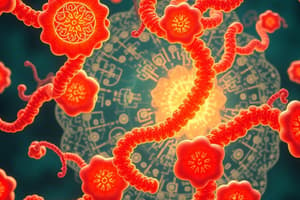Podcast
Questions and Answers
What are integral proteins?
What are integral proteins?
- Proteins that are embedded in the membrane and can span across it (correct)
- Proteins that are found only in the cytoplasm
- Proteins that only associate on one side of the membrane
- Proteins that are completely hydrophobic
What are peripheral proteins?
What are peripheral proteins?
Peripheral proteins are not associated with the hydrophobic interior of the lipid bilayer and associate via non-covalent interactions with other membrane proteins or directly with lipid head groups.
What are lipid-linked membrane proteins?
What are lipid-linked membrane proteins?
Lipid-linked membrane proteins are anchored in the bilayer by a lipid linkage at the cytosolic surface or the extracellular surface.
What is the fluid mosaic model of the cell membrane?
What is the fluid mosaic model of the cell membrane?
What is the function of the cell membrane?
What is the function of the cell membrane?
Polar is hydrophobic while non-polar is hydrophilic.
Polar is hydrophobic while non-polar is hydrophilic.
What are the learning outcomes related to biological membranes?
What are the learning outcomes related to biological membranes?
Describe the relationship between membrane physical properties and their chemical composition.
Describe the relationship between membrane physical properties and their chemical composition.
What are the types of membrane lipids?
What are the types of membrane lipids?
Which type of protein can span the lipid bilayer?
Which type of protein can span the lipid bilayer?
Cholesterol is a type of __________.
Cholesterol is a type of __________.
Flashcards are hidden until you start studying
Study Notes
Integral Proteins
- Integral proteins are amphipathic, possessing both hydrophobic and hydrophilic regions.
- Hydrophobic portions interact with the lipid bilayer's core.
- Can be classified as single-pass or multi-pass transmembrane proteins based on the number of times they traverse the bilayer.
- Single-pass transmembrane proteins cross the membrane once, while multi-pass proteins cross multiple times.
Peripheral Proteins
- Peripheral proteins do not penetrate the lipid bilayer.
- They associate indirectly with the membrane through non-covalent interactions with other proteins or directly with the hydrophilic heads of lipids.
Lipid-Linked Membrane Proteins
- Lipid-linked proteins are anchored to the membrane by lipid attachments at either the cytosolic or extracellular surfaces.
Fluid Mosaic Model
- Represents the cell membrane as a fluid lipid bilayer embedded with proteins.
- Highlights the mobility of lipids and proteins within the membrane.
Function of the Cell Membrane
- Regulates the transport of solutes in and out of the cell, maintaining homeostasis.
Polar vs Non-Polar
- Polar molecules are hydrophilic (water-loving), while non-polar molecules are hydrophobic (water-hating).
Learning Outcomes
- Describing membrane structure and properties (fluid-mosaic model, lipid rafts).
- Explaining the chemical environment's impact on membrane protein structure.
- Understanding factors influencing water movement across membranes.
- Interpreting how ion gradients create membrane potential.
- Differentiating between passive diffusion, facilitated transport, and active transport.
- Outlining the secretory pathway and endocytosis for substance transport.
Structure-Function Relationship
- The physical and chemical properties of membranes are key to their biological functions, necessitating an exploration of their molecular components.
Types of Membrane Lipids
- Phospholipids: Include phosphatidylcholine (PC), phosphatidylserine (PS), phosphatidylethanolamine (PE), and phosphatidylinositol (PI); characterized by a hydrophilic head and hydrophobic tails.
- Glycolipids: Feature sugar residues as hydrophilic heads; can be glycerol-based or sphingosine-based.
- Cholesterol: An amphipathic sterol with a unique four-ring structure; influences membrane fluidity.
Types of Membrane Proteins
- Integral Proteins: Span the lipid bilayer, include transmembrane proteins (single-pass and multi-pass types).
- Peripheral Proteins: Interact with the membrane without spanning it; often exposed to the cytoplasmic or extracellular space.
Studying That Suits You
Use AI to generate personalized quizzes and flashcards to suit your learning preferences.




